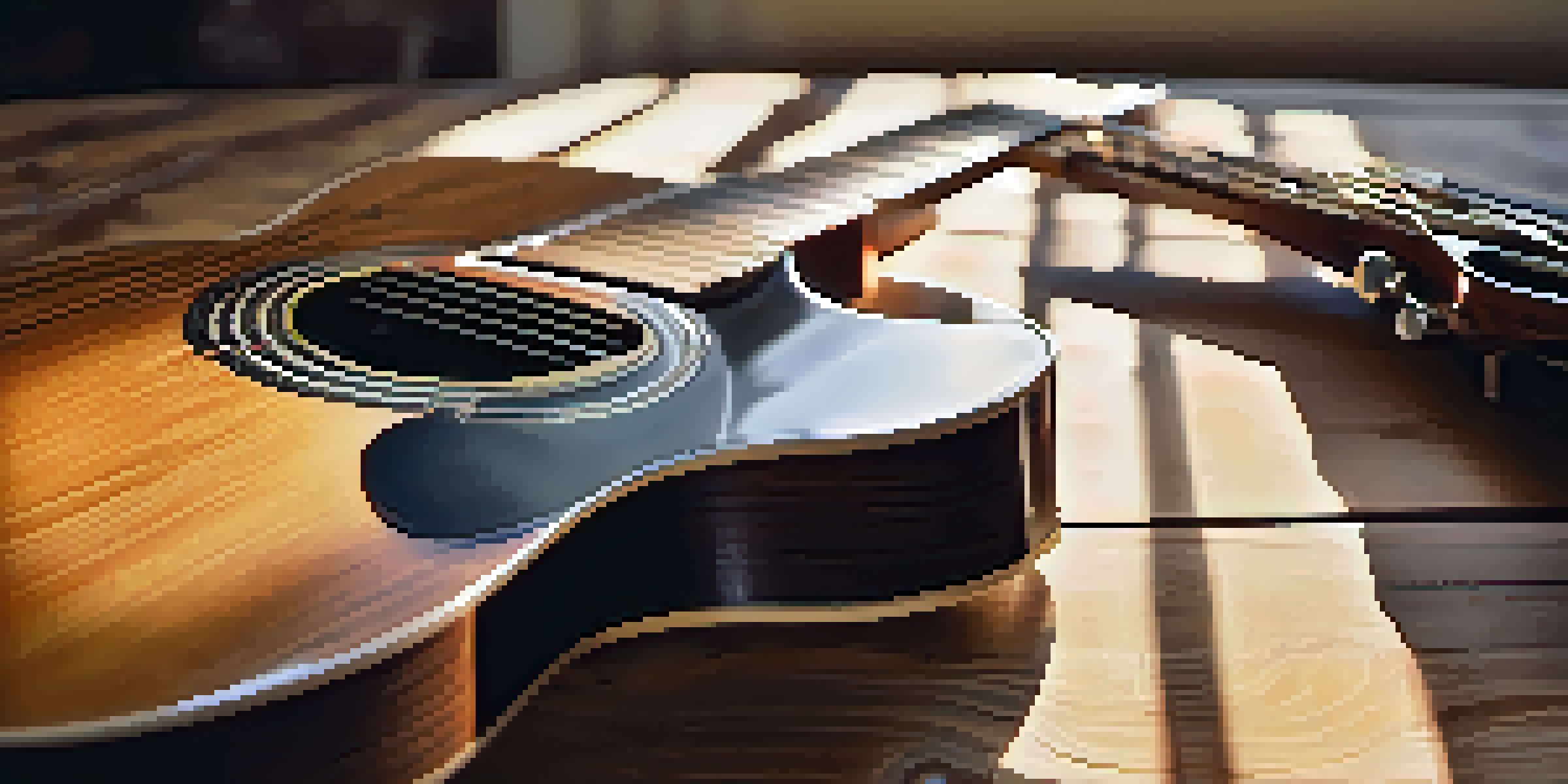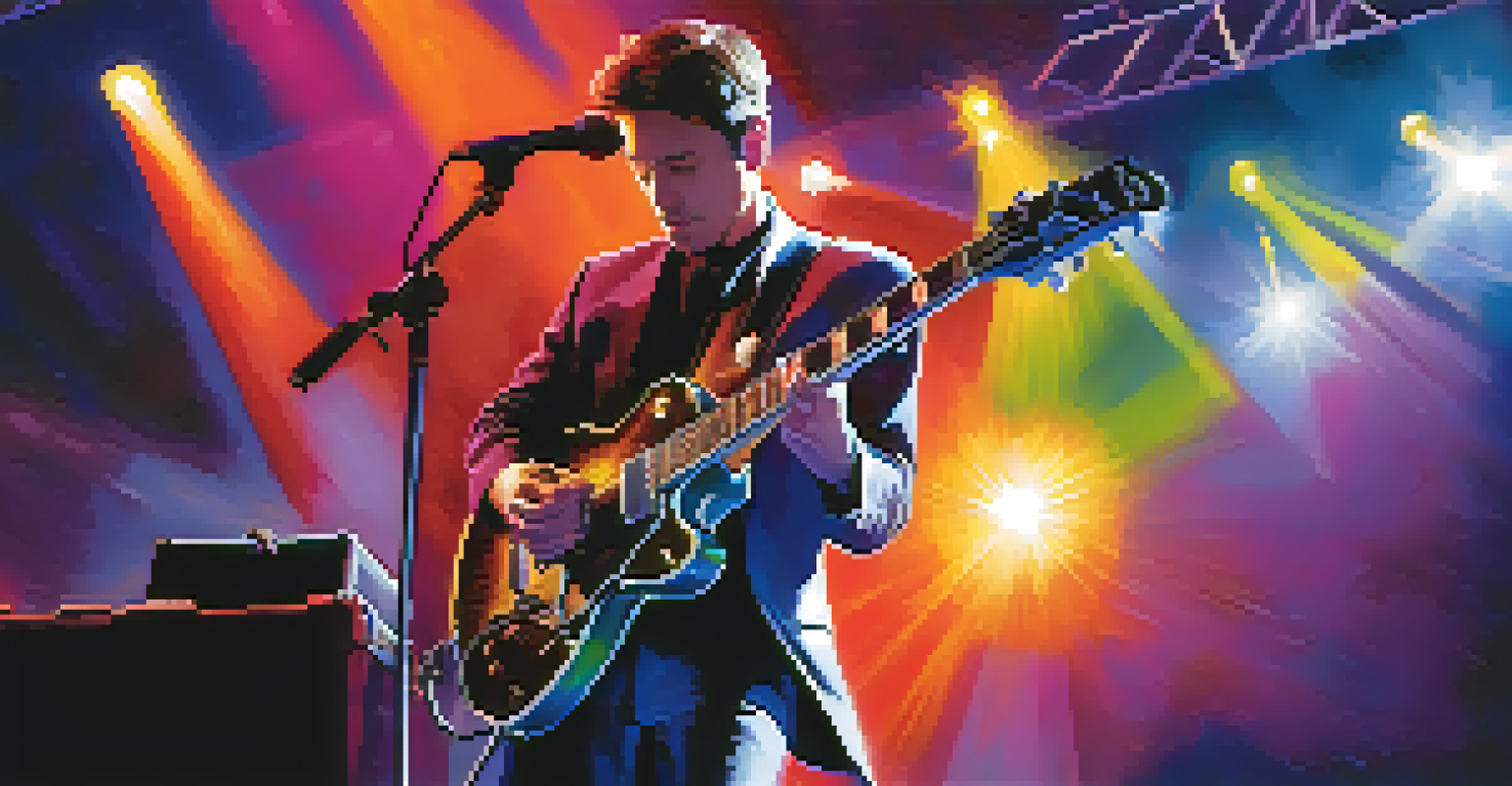The Role of Timing and Rhythm in Guitar Improvisation

Understanding Timing in Guitar Improvisation
Timing is the backbone of any musical performance, especially in improvisation. It refers to when notes are played in relation to the beat, creating a sense of movement and flow. Mastering timing means knowing when to play ahead, on, or behind the beat, which can dramatically affect the feel of your music.
Timing is everything. If you don't have good timing, you don't have good music.
Consider a drummer playing a steady beat; if a guitarist plays notes that sync perfectly with it, the result is a cohesive sound. However, if the guitarist chooses to play slightly ahead or behind the beat, it can introduce tension and excitement, adding depth to the improvisation. This dynamic interplay is what keeps the listener engaged.
Incorporating timing into your practice routine can improve your improvisational skills significantly. Use a metronome to explore different tempos and develop a strong internal clock. Remember, great improvisation stems not just from what notes you play, but when you choose to play them.
The Importance of Rhythm in Musical Expression
Rhythm is more than just a sequence of beats; it's the pattern that gives music its identity. In guitar improvisation, the rhythm shapes how phrases are delivered, influencing the overall mood of the piece. Think of rhythm as the heartbeat of your music, guiding the listener through your performance.

For instance, a fast, syncopated rhythm can create an exhilarating atmosphere, while a slower, more legato rhythm can evoke feelings of calmness or nostalgia. This versatility allows guitarists to express a wide range of emotions through their improvisation. By experimenting with different rhythms, you can discover unique ways to convey your musical ideas.
Mastering Timing Enhances Improvisation
Understanding when to play notes in relation to the beat can significantly elevate your guitar improvisation.
Practice varying your rhythmic patterns during improvisation. Try playing the same notes with different rhythms to see how they change the feel of a piece. This exercise not only enhances your skills but also opens new avenues for creativity.
Syncopation: Adding Interest to Your Playing
Syncopation is a rhythmic technique that emphasizes beats or parts of beats that are typically not accented. It can add a surprising twist to your guitar improvisation, making it more engaging for the listener. For example, instead of playing on the downbeat, you might choose to accent a beat in the middle of a measure, creating an unexpected groove.
Rhythm is the heartbeat of music, and it is a powerful tool for expression.
This approach can break the monotony of straightforward rhythms and invite listeners to pay closer attention. Many genres, like jazz and funk, heavily rely on syncopation to create intricate and captivating soundscapes. By incorporating syncopated rhythms into your playing, you can elevate your improvisation and showcase your musicality.
To practice syncopation, start by playing a simple rhythm and then experiment with shifting some notes to off-beats. This exercise will help you develop a keen sense of timing and rhythm, allowing you to use syncopation more effectively in your improvisation.
Creating Tension and Release Through Rhythm
Tension and release are fundamental elements in music that keep listeners engaged. In guitar improvisation, you can create tension by playing with rhythm, such as speeding up or using complex patterns. This builds anticipation, making the eventual release—often through a more straightforward rhythm—feel even more satisfying.
Imagine a suspenseful movie scene where the music builds up only to suddenly drop into a calm melody. This technique can be mirrored in your guitar playing by experimenting with rhythmic complexity and then resolving it into a simpler, catchy riff. This contrast can be very impactful in live performances.
Rhythm Shapes Musical Expression
Varying rhythmic patterns allows guitarists to convey a wide range of emotions and keep listeners engaged.
To master this technique, practice sections of your improvisation where you intentionally create tension through rapid, intricate rhythms, followed by a contrasting release. The ability to manipulate timing and rhythm in this way not only enhances your improvisation but also captivates your audience.
Using Rhythm to Shape Melodic Phrases
Melody and rhythm are intertwined, with each influencing the other. When improvising on the guitar, consider how your rhythmic choices can shape the melodic phrases you create. A well-timed note can make a simple melody feel like a masterpiece, while poor timing can detract from even the most beautiful lines.
For instance, if you play a melodic phrase with a steady rhythm, it may sound pleasant but predictable. Conversely, incorporating varied rhythms into your phrases can add excitement and intrigue, drawing the listener in. The rhythmic placement of each note can transform a straightforward melody into something captivating.
To explore this concept, take a familiar melody and experiment with different rhythmic interpretations. Change the duration of certain notes or add rests to see how it alters the feel of the piece. This practice will enhance your improvisational skills and help you develop your unique style.
Practicing Timing and Rhythm with Backing Tracks
Backing tracks are an excellent tool for practicing timing and rhythm in guitar improvisation. They provide a musical context that can help you hear how your improvisation interacts with other instruments. By jamming along with these tracks, you can develop a better understanding of timing and how to fit your playing within a larger framework.
When using backing tracks, pay attention to how your rhythms complement the groove of the band. Try to match your timing with the rhythm section, as this partnership is crucial for creating a cohesive sound. Additionally, experimenting with different genres can expose you to various rhythmic patterns and styles.
Feel and Groove Connect with Audiences
Developing a strong sense of feel and groove through timing and rhythm creates a deeper emotional connection with listeners.
As you practice, challenge yourself by playing with tracks at different tempos and styles. This will not only improve your timing but also diversify your improvisational skills, allowing you to adapt your playing to various musical situations.
The Role of Feel and Groove in Improvisation
Feel and groove are often described as the essence of music that makes you want to move. In guitar improvisation, they stem from your timing and rhythm, making it crucial to develop a strong sense of these elements. When you play with feel, you connect more deeply with your audience, allowing them to experience the emotion behind your music.
Groove refers to the rhythmic feel that makes listeners tap their feet or nod their heads. It’s about creating a rhythmic foundation that invites others to join in the experience. A guitarist who masters groove can elevate their improvisation, making it more enjoyable for both themselves and their audience.

To cultivate feel and groove, listen to your favorite guitarists and pay attention to how they use timing and rhythm. Try to emulate their styles and incorporate their techniques into your playing. Over time, this practice will help you develop a unique groove that reflects your personality as a musician.